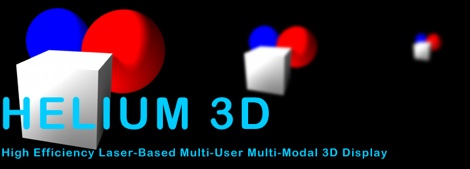A revolutionary interactive 3DTV system is being created by De Montfort University Leicester (DMU), England, researchers. The €4.2 million (approx £3.7 million) project aims to develop a television that can recognise where somebody is sitting in a room and what they wish to view and interact with on their television. Researchers believe it is a step towards truly interactive 3D video games where gamers use their bodies to control the action without the need for a controller. It could be the next step for Microsoft’s Project Natal. The project, called HELIUM3D (high efficiency, laser-based, multi-user, multi-modal 3D display) is also exploring ways of allowing viewers who are watching the same television to each view a different channel at the same time and could even let them choose different viewing positions within the image. For example, groups of people watching a football match in the same room could each pick the part of the stadium from which they would like to experience the action.
The 3D effect will be seen without special glasses and will use head-tracking technology developed during previous 3DTV research projects led by DMU to deliver the perfect image to every viewer.
The system will not only display standard 3DTV, it will also allow viewers to experience an effect known as motion parallax or the ‘look-around effect’. This is where the image has a ‘holographic’ quality, giving it a greater sense of depth and movement than standard 3D.
Researchers at DMU’s Imaging and Displays Research Group (IDRG) are leading the work, with partners from: Fraunhofer Heinrich-Hertz-Institut; Philips Consumer Lifestyle; Eindhoven University of Technology; Nanjing University in China; Barco, a display hardware manufacturer in Belgium; University College London; and Koç University in Turkey.
The project is supported by £2.8 million funding from the European Commission’s Framework 7 programme.
Researchers working on HELIUM3D will also be exploring the display’s potential in professional applications, including medical imaging, video conferencing, engineering design and oil and gas exploration.
DMU’s Dr Ian Sexton, head of the imaging and displays research group, said: “The inherent flexibility of the HELIUM display takes it beyond mere 3D and will open up a whole new world of exciting interactive possibilities. The display will give gamers a new freedom to enjoy interactive 3D television and games - for example viewers or gamers will be able to see 3D on the HELIUM TV and also interact with the game through the viewer sensing built into the system wherever they are in the room and without 3D glasses. This will make 3D games more natural, exciting and ‘real’. The system will also be used for more serious uses such as medical imaging; doctors and surgeons will be able to intuitively ‘fly’ through a 3D scan of a person to make a diagnosis or to prepare for an operation, making a 3D display that will be useful to a wide audience.”
Previous 3D systems have used flat panel displays in their design but HELIUM3D will use a new type of front screen.
The Gabor superlens screen used by DMU researchers replaces the usual LCD screen found on commercial television sets and is much more efficient than other technologies.
This will allow brighter whites and darker blacks, meaning the resulting image will be much more vivid than in previous 3D projects due to the use of a novel red, green and blue laser illumination source.
The HELIUM3D funding from the European Commission is the latest in a string of projects which the IDRG has worked on over the past seven years, worth nearly £14 million in total.
HELIUM3D runs until 2010 and researchers hope the system will lead to commercial production of interactive 3DTV sets within the next decade.


